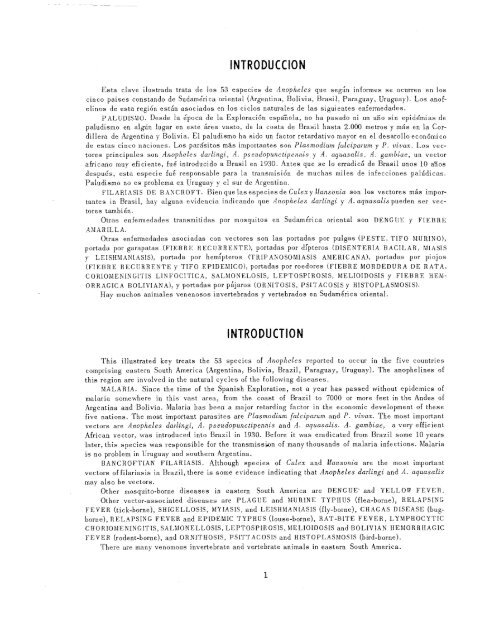clave ilustrada para los mosquitos anofelinos de sudamerica oriental
clave ilustrada para los mosquitos anofelinos de sudamerica oriental
clave ilustrada para los mosquitos anofelinos de sudamerica oriental
Create successful ePaper yourself
Turn your PDF publications into a flip-book with our unique Google optimized e-Paper software.
INTRODUCCION<br />
Esta <strong>clave</strong> <strong>ilustrada</strong> trata <strong>de</strong> 10s 53 especies <strong>de</strong> ;ZnopheZes que se&n informes se ocurren en 10s<br />
cinco paises constando <strong>de</strong> Sudamerica <strong>oriental</strong> (Argentina, Bolivia, Brasil, Paraguay, Uruguay). Los anof-<br />
elinos <strong>de</strong> esta region es&r asociados en 10s cic<strong>los</strong> naturales <strong>de</strong> las siguientes enfermeda<strong>de</strong>s.<br />
PALUDISMO. D es e<br />
d 1 a e’poca <strong>de</strong> la Exploraci6n espaxola, no ha pasado ni un aZo sin epi<strong>de</strong>’mias <strong>de</strong><br />
paludismo en algun lugar en este Area vasto, <strong>de</strong> la costa <strong>de</strong> Brasil hasta 2.000 metros y mGs en la Cor-<br />
dillera <strong>de</strong> Argentina y Bolivia. El paludismo ha sido un factor retardativo mayor en el <strong>de</strong>sarollo econ6mico<br />
<strong>de</strong> estas cinco naciones. Los par&itos m&s importantes son Plasmodium falciparum y P. vivax. Los vet-<br />
tores principales son Anopheles darlingi, A. pseudopunctipennis y il. aquasalis. A. gambiae, un vector<br />
afri can0 muy efi ciente, fue’ introducido a Brasil en 1930. Antes que se lo erradic6 <strong>de</strong> Brasil unos 10 aFios<br />
<strong>de</strong>spue’s, esta especie fuk responsable <strong>para</strong> la transmisidn <strong>de</strong> muchas miles <strong>de</strong> infecciones paltidicas.<br />
Paludismo no es problema en Uruguay y el sur <strong>de</strong> Argentina.<br />
FILARIXSIS DE BANCROFT. Bien que las especies <strong>de</strong> Culexy illansonia son 10s vectores m6s impor-<br />
tantes in Brasil, hay alguna evi<strong>de</strong>ncia indicando que Anopheles darlingi y A. aquasalispue<strong>de</strong>n ser vec-<br />
tores tambi e’n.<br />
Otras enfermeda<strong>de</strong>s transmitidas por <strong>mosquitos</strong> en Sudame’rica <strong>oriental</strong> son DENGUE y FIEBRE<br />
AMARILLA.<br />
Otras enfermeda<strong>de</strong>s asociadas con vectores son las portadas por pulgas (PESTE, TIFO MuRINO),<br />
portada por garapatas (FIEBRE RECURRENTE), portadas por dcpteros (DISENTERIA BACILAR, hIIASIS<br />
y LEISH~IANIASIS), portada por hemtpteros (TRIPANOSOMJASIS AMERICANA), portadas por piojos<br />
(FIEBRE RECURRENTE y TIFO EPIDEMICO), portadas par roedores (FIEBRE MORDEDURA DE RATA,<br />
CORIO?ilE~IKGITIS LINFOCITICX, SALhlONELOSIS, LEPTOSPIROSIS, MELIOIDOSIS y FIEBRE HEhI-<br />
ORRAGICA BOLIVIANA), y portadas porp&jaros (ORNITOSIS, PSITACOSIS~ HISTOPLASMOSIS).<br />
Hay muchos animales venenosos invertebrados y vertebrados en Sudame’rica <strong>oriental</strong>.<br />
INTRODUCTION<br />
This illustrated key treats the 53 species of Anopheles reported to occur in the five countries<br />
comprising eastern South America (Argentina, Bolivia, Brazil, Paraguay, Uruguay). The anophelines of<br />
this region are involved in the natural cycles of the following diseases.<br />
hIALARIA. Since the time of the Spanish Exploration, not a year has passed without epi<strong>de</strong>mics of<br />
malaria somewhere in this vast area, from the coast of Brazil to 7000 or more feet in the An<strong>de</strong>s of<br />
Argentina and Bolivia. Malaria has been a major retarding factor in the economic <strong>de</strong>velopment of these<br />
five nations. The most important <strong>para</strong>sites are Plasmodium falciparum and P. vivax. The most important<br />
vectors are Anopheles darlingi, A. pseudopunctipennis and A. aquasalis. A. gambiae, a very efficient<br />
African vector, was introduced into Brazil in 1930. Before it was eradicated from Brazil some 10 years<br />
later, this species was responsible for the transmission of many thousands of malaria infections. Malaria<br />
is no problem in Uruguay and southern Argentina.<br />
BANCROFTIAN FILARIASIS. Although species of Culex and Mansonia are the most important<br />
vectors of filariasis in Brazil, there is some evi<strong>de</strong>nce indicating that Anopheles darlingi and A. aquasalis<br />
may also be vectors.<br />
Other mosquito-borne diseases in eastern South America are DENGUE' and YELLON FEVER.<br />
Other vector-associated diseases are PLAGUE and MURINE TYPHUS (flea-borne), RELAPSING<br />
FEVER (tick-borne), SHIGELLOSIS, MYIASIS, and LEISHhlANIASIS (fly-borne), CHAGAS DISEASE (bug-<br />
borne), RELAPSING FEVER and EPIDEhlIC TYPHUS (1 ouse-borne), RAT-BITE FEVER, LYMPHOCYTIC<br />
CHORIOhlENI~GITIS,SALhlOhTELLOSIS,LEPTOSPIROSIS,hlELIOIDOSIS andBOLIVIAK HEMORRHAGIC<br />
FEVER (ro<strong>de</strong>nt-b orne), and ORNITHOSIS, PSITTACOSIS and HISTOPLAShlOSIS (bird-borne).<br />
There are many venomous invertebrate and vertebrate animals in eastern South America.<br />
1
















